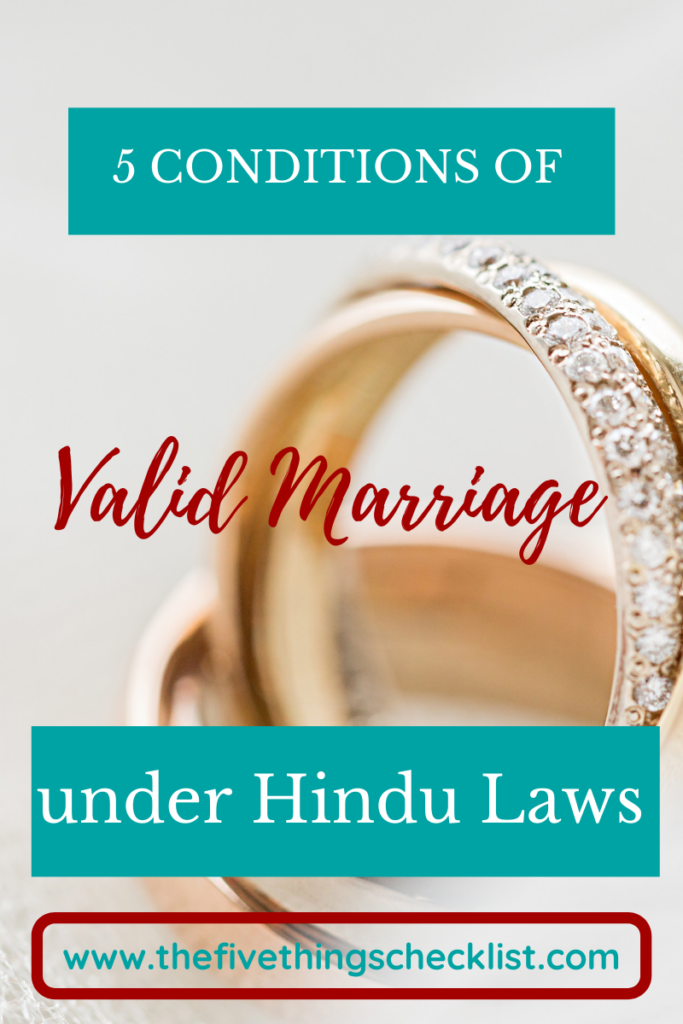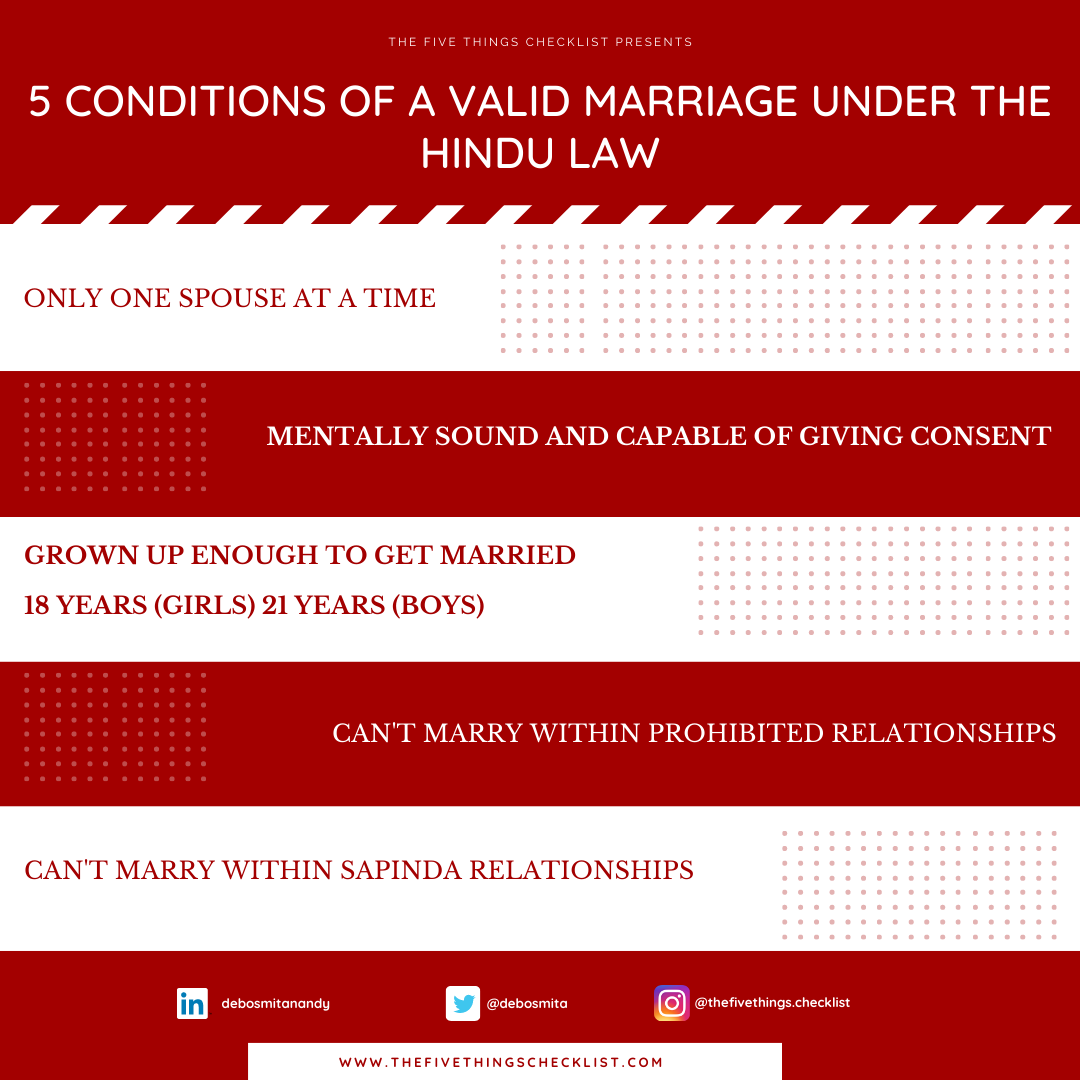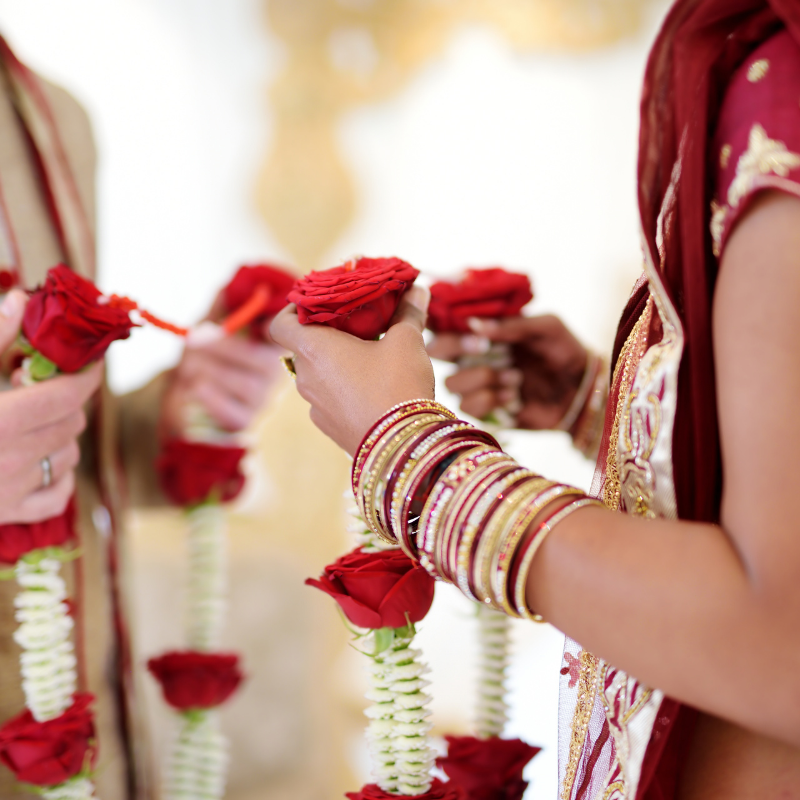This is a guest post written by Anuj Valiya Rakkanchath, a second-year student of the 3-year LLB course of Jitendra Chauhan College of Law, Mumbai.
Planning to elope with your partner and getting married in the temple, Bollywood style? Make sure you read this article and know what constitutes a valid marriage under the Hindu Law.
What is Marriage under the Hindu Marriage Act, 1955?
The meaning of a marriage under the Hindu Personal Laws is not at all what you would expect.
As per the Hindu personal law, marriage is considered to be the very foundation of a stable family and civilised society; it’s a sacred institution that awards status and security to the parties and their offsprings. It is a religious sacrament in which a man and a woman are bound in a permanent relationship for physical, social and spiritual purposes of dharma, procreation and sexual pleasure.
The term marriage, in general, would be defined as a consensual and contractual union of a man and woman in the eyes of the society while being recognised by the law.
Interesting point to note – when it comes to Hindu Law, marriage is termed as a sacred relationship and in Muslim law, marriage is defined as a contractual relationship.
What are the goals of a Hindu Marriage?
DHARMA SAMPATTI, also known as a Fulfilment of Dharma or religious duties: Marriage is desired not so much for sex or for progeny as for obtaining a partner for the fulfilment of one’s religious duty.
PRAJA SAMPATTI, also known as Procreation; this is regarded as the second most important aim of Hindu marriage. The Hindu thinkers regarded this as a duty towards both the family and the community as well as for one’s salvation.
RATHI SUKHAM, also know as Kama or sex gratification; this was the least desirable goal for marriage especially in the eyes of the Hindu preachers, hence it was placed as the last aim of a Hindu marriage.
There are some certain prerequisites and conditions are essential for a valid marriage in the eyes of the law according to the Hindu Marriage Act, 1955.
Of course, the most important one is that both parties to the marriage are Hindus.
For a marriage to be solemnized between any two Hindus, it must follow the conditions that are present in Section 5 of the Hindu Marriage Act, 1955.
Let’s see what are the conditions for a valid marriage under Hindu Laws.

MONOGAMY – Section 5 (i)
Now let’s assume that Mr.X gets married to Ms Y by following all the required ceremonies but after a month into the marriage, it was discovered by Ms Y that Mr.X was already married to Ms.A according to their customs and religion.
Then in this case the marriage between Mr.X and Ms.Y will be held null and void.
Apart from the marriage being null and void Mr.X is liable under Section 494 or Section 494 of IPC for a punishment leading up to 7 or 10 years along with a fine depending on the details of the case.
If either party has a spouse living at the time of the marriage and not divorced from their former partner or spouse, then that marriage under the Hindu Laws is not considered as a valid marriage.
In a simpler term, this act prohibits bigamous marriage and Section 11 declares such a bigamous marriage void. A person indulging in such a marriage makes himself open to penal liability under Section 494 and 495 of the Indian Penal Code.
SOUNDNESS OF MIND – Section 5 (ii)
The next important prerequisite for a valid marriage under Hindu Law is the soundness of mind.
Firstly, the ability of both parties to be able to give valid consent for their marriage, for which a sound mind is an essential rudiment. So if either party is suffering from an unsound mind or is a lunatic at the time of marriage then a valid marriage is said to have not taken place.
Secondly, if either party despite being able to give valid consent for their marriage but suffers from any mental disorder to such an extent that the party becomes unfit for marriage and/or if either party is not capable of procreation of children even then the marriage would be taken as an invalid marriage. Such a marriage is not per se void but voidable under Section 12 of the Hindu Marriage Act, 1955.
Thirdly, if either party to the marriage has been a subject to recurrent attacks of insanity he or she is also not qualified for a marriage under the Hindu Marriage Act.
Now you know that all those Bollywood movies showing marriage with a lunatic hero, get this fundamental law all wrong.
AGE OF MARRIAGE – Section 5 (iii)
The next prerequisite for a valid marriage is the age of the parties to the marriage as defined by the law. The age of the bridegroom must be 21 years, while the age of the bride should be 18 years at the time of the marriage.
Violation of this rule won’t make the marriage void or voidable but would attract penalties which would lead up to 15 days of imprisonment or with a fine up to Rs. 1000 or with both.
This marriage becomes a valid condition to repudiate or deny the marriage by the minor.
But, if the marriage was between a bridegroom whose age at the time of marriage was above 21 years while the bride’s age was below 18 years would attract punishment under the Prohibition of Child Marriage Act, 2006, leading up to rigorous imprisonment which may extend to two years or with fine which may extend to one lakh rupees or with both.
NOT WITHIN PROHIBITED RELATIONSHIP – Section 5 (iv)
In this rule, the Hindu Marriage Act, 1955 calls out the fact that the parties entering into marriage with each other shouldn’t be in a prohibited relationship.
Firstly, a prohibited relationship is defined as a relationship whereby one is a lineal descendant of the other. This includes direct blood relatives falling as a descendant such as children, grandchildren, great children and so on. All these categories fall under a prohibited relationship under the Act.
Secondly, a relationship by affinity is also categorised as a prohibited relationship under this act. In other words, if one is the husband or wife of their blood relative it falls under a prohibited relationship.
For example, A marriage between the father-in-law and daughter-in-law or mother-in-law and son-in-law or stepmother and stepson or stepfather and stepdaughter are thus within the degrees of a prohibited relationship under this act.
Thirdly, a marriage with the wife or sister of any brotherly relation also falls under a prohibited relationship.
For example, If ‘A’ marries his adopted sister or If ‘B’ marries the wife of his pre-deceased brother, then both the marriages are invalid since in the first case A is related to his adopted sister by his parents and in the second instance B is related to the wife of his pre-deceased brother by his own brother.
But, there is one exception to all these kinds of prohibited relationships, which is, if the custom or usage governing each of the parties permits such a kind of marriage between them.
NOT WITHIN SAPINDA RELATIONSHIP – Section 5 (v)
According to the Mitakshara Law of Marriage ‘Pinda’ means body and therefore those who are related by body or blood are sapindas among themselves.
According to the Mitakshara definition adopted by the Act, the extent of Sapinda relationship is limited to 5 degrees in line of ascent/upwards through the father and 3 degrees in the line of ascent/upwards through the mother. Any marriage that falls under the sapinda relationship is held as an invalid marriage.
For example, Marriage between ‘X’ and his father’s sister falls under a sapinda relationship or if ‘P’ the daughter of ‘Q’ marries her mother’s brother or father, it would fall under the same category of an invalid marriage.
But, in the same case as the previous rule, If the custom or usage governing each of them permits of a marriage between the two, then such marriage is valid.

These are the 5 prerequisites which are to be followed to ensure a valid marriage under the Hindu Marriage Act, 1955.
Hope you got a good idea from this article written by Anuj. Please leave a comment if you have any question or feedback.
If you want to write a guest post, you are welcome to submit your article. The Submission Guidelines are available here.
The earlier guest post by Anurag on Rules of Evidence can be found here.
Share this article with your friends with a single click.
